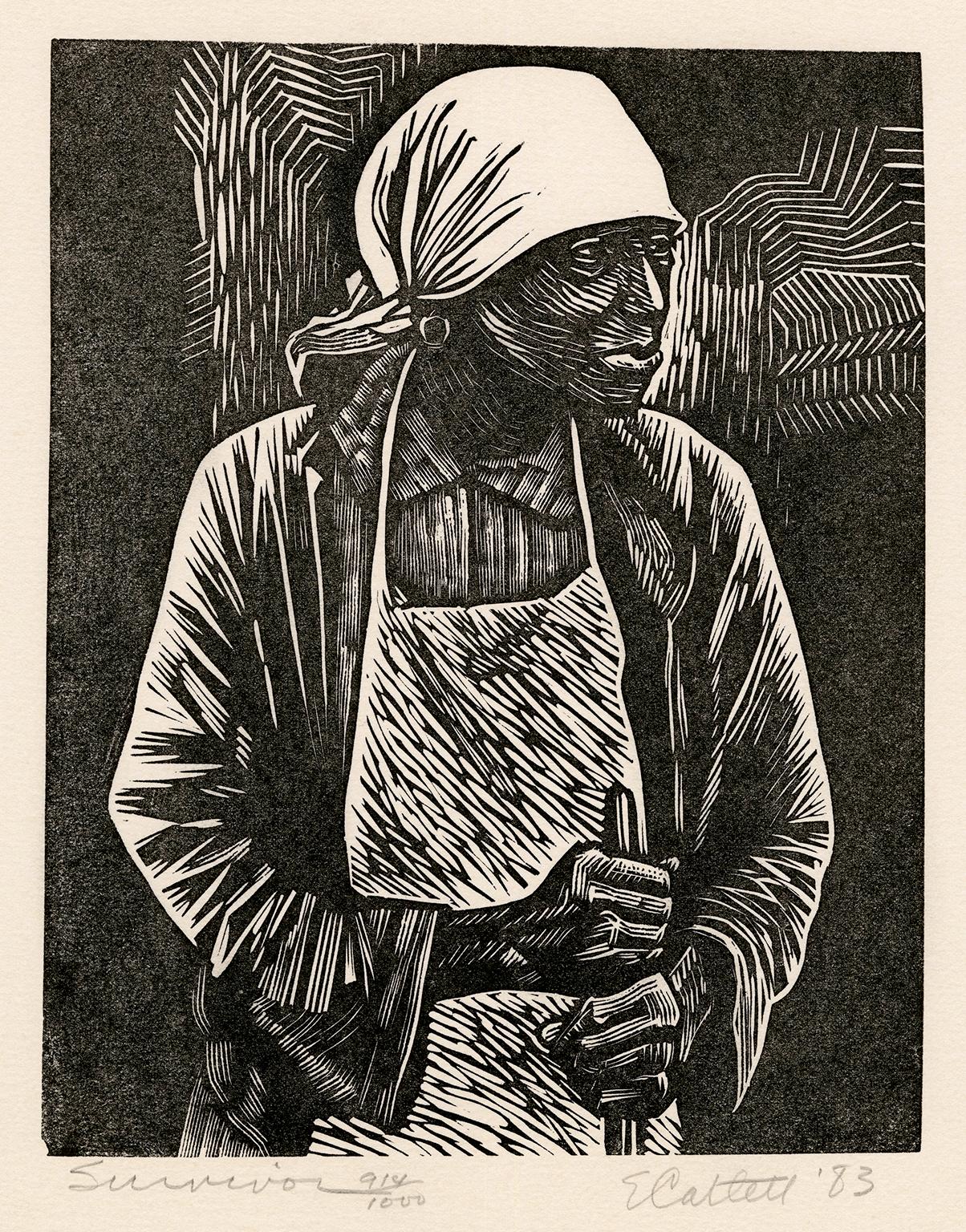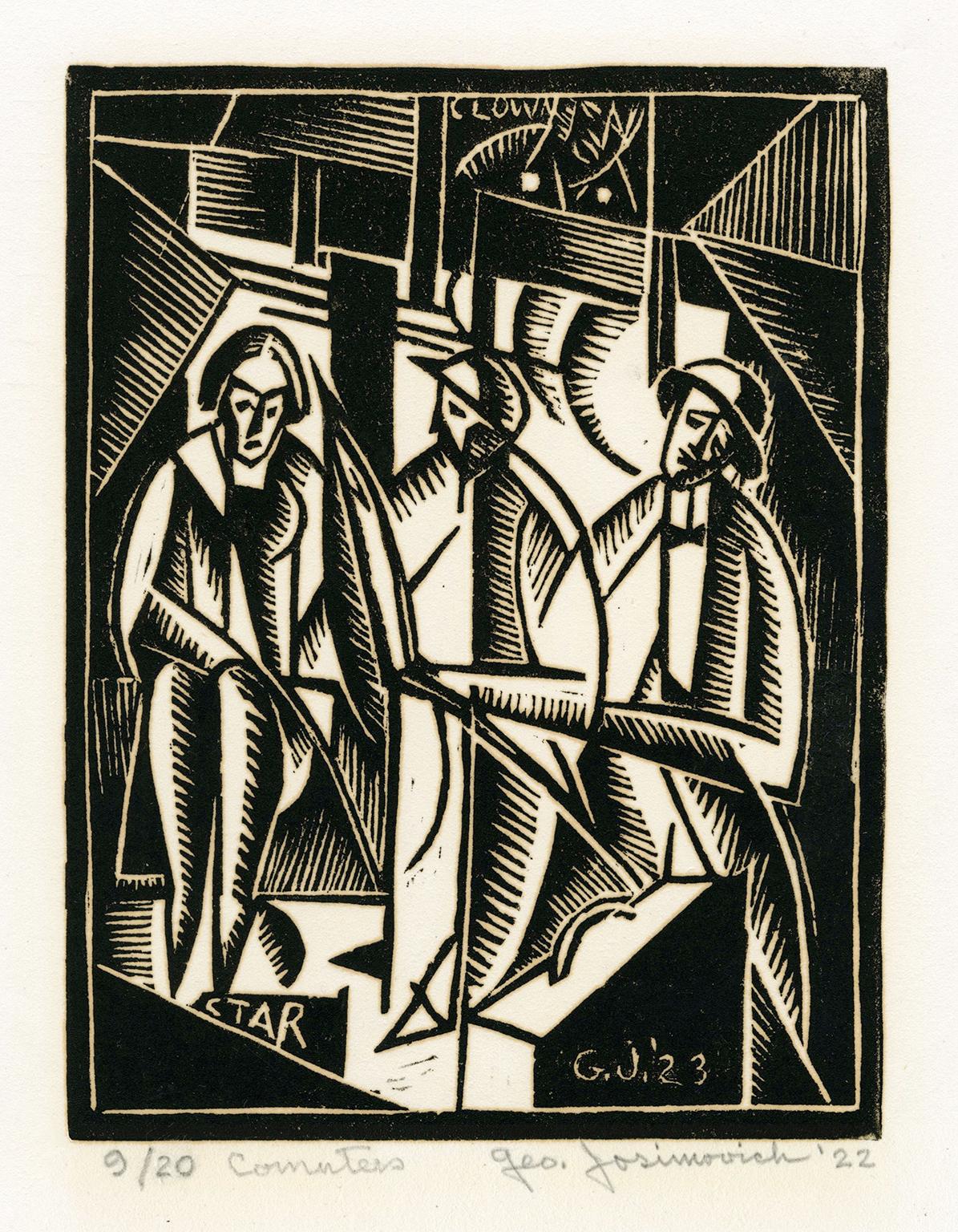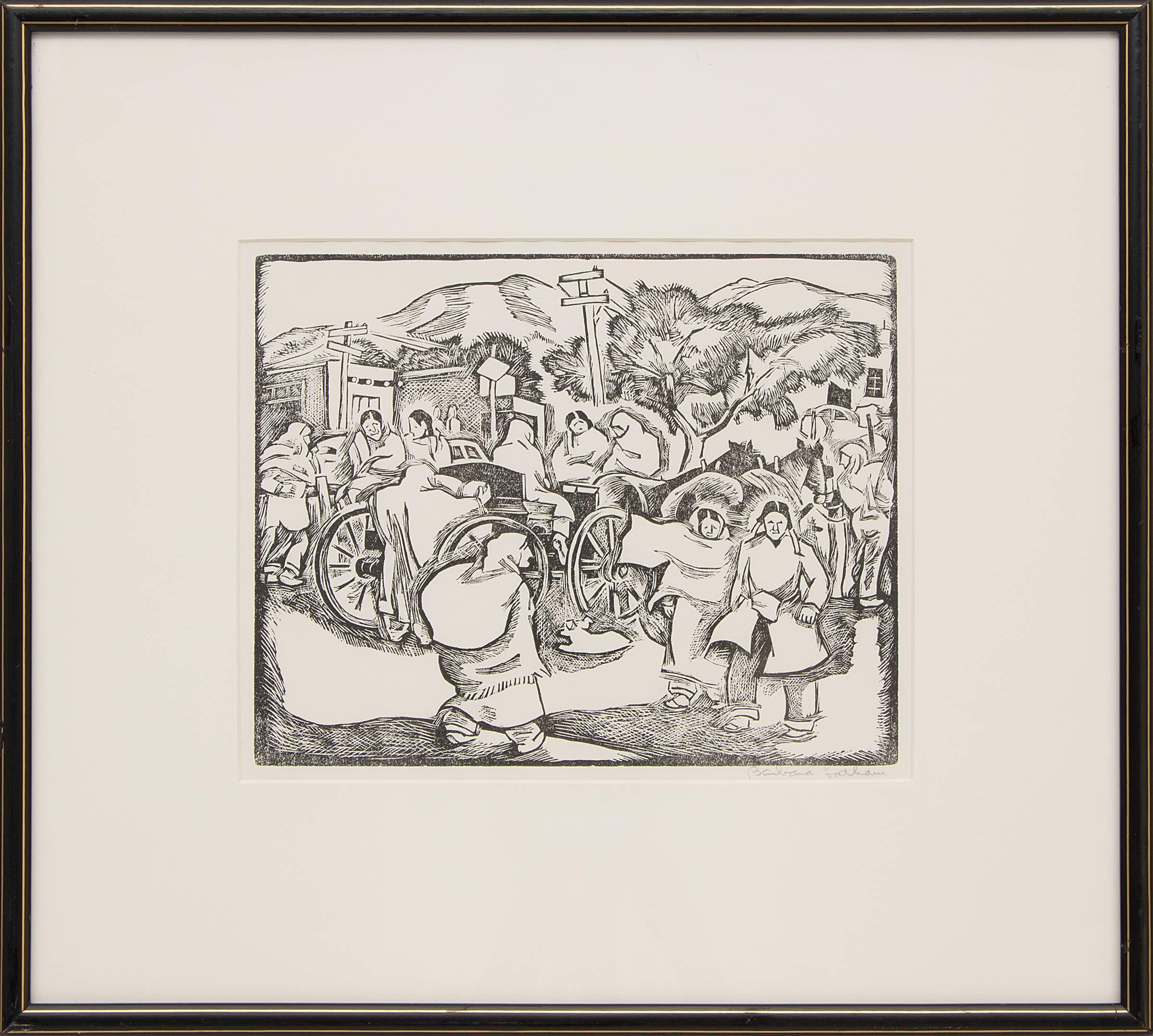Objekte ähnlich wie Harbor mit Segelbooten Anfang des 20. Jahrhunderts Modernismus
Möchten Sie mehr Bilder oder Videos?
Zusätzliche Bilder oder Videos von dem*der Anbieter*in anfordern
1 von 3
George JosimovichHarbor mit Segelbooten Anfang des 20. Jahrhunderts Modernismus1923
1923
Angaben zum Objekt
George Josimovich, Untitled (Harbor with Sailboats) ', linocut, 1923, edition 35. Signed, dated, and annotated '4/35' in pencil. Initialed 'G J' in the matrix, lower left. A fine, richly-inked impression, on cream wove Japan paper, with full margins (7/8 to 2 3/4 inches), in excellent condition. Selten. Image size 9 x 8 inches (225 x 203 mm); sheet size 14 1/2 x 10 3/4 inches (368 x 273 mm). Passepartout nach Museumsstandard, ungerahmt.
“Life is in a constant state of flux-never-ceasing motion. Everything breathes, moves, vibrates. And it is my ardent belief that the same should be true in a work of art. It should be alive, dynamically alive. Every part of it should live and every part of it should contribute life to the creation as a whole. ...anyone who is sensitive and creative enough to deserve to be called an artist will consciously or unconsciously react to...those phases of life with which his particular nature and personality have a special kinship. And all this cannot help but leave an impress upon his work which is and must be, if it is sincere, an objective manifestation of his inner self.” —George Josimovich, Illinois Historical Art Project
ABOUT THE ARTIST
Born in Mitrovica, Yugoslavia (present-day Serbia), George Josimovich (1894 - 1986) immigrated to the United States with his parents and three younger brothers in 1908. The family settled in Fort Laramie and Cheyenne, Wyoming, along the Union Pacific Railroad, where his father worked as a tailor. In 1914, motivated by a newspaper advertisement for the Lockwood Art School in Kalamazoo, Michigan, Josimovich set out for the Midwest to pursue a career in art.
From 1914–19 he studied at the School of the Art Institute of Chicago (SAIC) under Karl Buehr and Randall Davey, and alongside fellow students William Schwartz, Emil Armin, and Archibald J. Motley Jr. During his final year at SAIC, Josimovich enrolled in a life class with visiting professor George Bellows, whose teachings about avant-garde art, geometric composition, color theory, and individualism in art exerted a profound influence. An exhibition of applied arts by German artist Hermann Sachs at the Art Institute of Chicago during the winter of 1920–21 also made a strong impression on the young artist. Josimovich studied under Sachs at Chicago’s Hull House and, along with other former SAIC students, followed Sachs to the Dayton Art Museum in Ohio to establish an expressionist craft program.
Josimovich returned to Chicago in 1922, where he joined the Jackson Park art colony and spent the next four years honing his craft and developing theories on composition and form. His works from this period evince a lively experimentation with modernist principles and techniques in oil and watercolor paintings, prints, and drawings. Familiar genres of figure study, still life, and landscape are distilled into abstract arrangements of fragmented forms in radically flattened pictorial space, often within tightly ordered geometric compositions. Throughout the 1920s Josimovich established himself as a leading contemporary artist in the city, exhibiting with the Chicago No-Jury Society of Artists, The Ten, and the Chicago Society of Artists, where he later served as president. Critics lauded him as quintessentially modern, praising his “rigid intellectualism” and his focus on color, form, and movement. Josimovich’s year in Paris in 1926–27, where he encountered other practitioners of abstraction and the theory of purism, further stimulated his modernist approach to art. His French sojourn culminated in a 1927 solo exhibition at the Galerie d’art contemporain in Paris, which garnered much coverage in the press.
In the 1930s, Josimovich dramatically transformed his art and became an expressionist in the vein of French painter Chaim Soutine. Soutine, who had emigrated to Paris in 1913 from Belarus, rose to international prominence through a major show at the gallery of Paul Guillaume in 1923 and subsequent purchases of his work by American collector Albert Barnes. Josimovich’s portraits, still lifes, and landscapes from this period bear some of the hallmarks of Soutine’s work in their exaggerated figures, quivering masses of color, and dynamic brushstrokes, and as a result, sparked strongly divided commentary among Chicago critics.
In the early 1930s, Josimovich was one of the organizers of the Fifty-seventh Street Art Colony, a group of artists with modernist sympathies, and worked briefly for the artists’ relief program of the Works Progress Administration. He continued to show his work through the 1950s in numerous group exhibitions at the Art Institute of Chicago, with the No-Jury Society of Artists and the Chicago Society of Artists, and in a solo exhibition at Knoedler’s Chicago gallery in 1932.
—edited from an essay by Patricia Smith Scanlan for ‘Modernism in the New City, Chicago Artists, 1920-1950’
- Schöpfer*in:George Josimovich (1894 - 1986)
- Entstehungsjahr:1923
- Maße:Höhe: 22,86 cm (9 in)Breite: 20,32 cm (8 in)
- Medium:
- Bewegung und Stil:
- Zeitalter:
- Zustand:
- Galeriestandort:Myrtle Beach, SC
- Referenznummer:
Informationen zu dem*der Anbieter*in
5,0
Anerkannte Anbieter*innen
Diese renommierten Anbieter*innen sind führend in der Branche und repräsentieren die höchste Klasse in Sachen Qualität und Design.
Platin-Anbieter*in
Diese von Expert*innen geprüften Anbieter*innen sind die erfahrensten Anbieter*innen von 1stDibs und werden von unseren Kund*innen am besten bewertet.
Gründungsjahr 1995
1stDibs-Anbieter*in seit 2016
257 Verkäufe auf 1stDibs
Typische Antwortzeit: 1 Stunde
Verbände
International Fine Print Dealers Association
- VersandAngebot wird abgerufen …Versand von: Myrtle Beach, SC
- RückgabebedingungenDie Rückgabe dieses Objekts kann innerhalb von 7 Tagen ab Lieferung veranlasst werden.
Einige Inhalte dieser Seite wurden automatisch übersetzt. Daher kann 1stDibs nicht die Richtigkeit der Übersetzungen garantieren. Englisch ist die Standardsprache dieser Website.
Mehr von diesem*dieser Anbieter*inAlle anzeigen
- Überlebender" - Elizabeth CatlettVon Elizabeth CatlettElizabeth Catlett, "Survivor", Linolschnitt, 1983, Auflage 1000. Mit Bleistift signiert, betitelt, datiert und nummeriert "914/1000". Schöner Abdruck auf schwerem, cremefarbenem Veli...Kategorie
1980er, Amerikanische Moderne, Figurative Drucke
MaterialienLinolschnitt
- „Kommoden“ Modernismus des frühen 20. JahrhundertsVon George JosimovichGeorge Josimovich, "Pendler", Linolschnitt, 1922-23, Auflage 20. Mit Bleistift signiert, datiert '22, betitelt und mit dem Vermerk "9/20" versehen. Unten rechts im Block paraphiert "...Kategorie
1920er, Amerikanische Moderne, Figurative Drucke
MaterialienLinolschnitt
- Brooklyn Bridge" - Ansicht eines ikonischen Wahrzeichens von New York City aus den 1920er JahrenVon Luigi KasimirLuigi Kasimir, "Brooklyn Bridge", Farbradierung mit Aquatinta, 1927, Auflage 100. Mit Bleistift signiert. Hervorragender Druck in frischen Farben auf schwerem, cremefarbenem Velin;...Kategorie
1920er, Amerikanische Moderne, Landschaftsdrucke
MaterialienRadierung, Aquatinta
- From the Sea (Von dem Meer - Pieta)Von Benton Murdoch SpruanceEin hervorragender, reich getuschter Abdruck auf cremefarbenem Velin; das ganze Blatt mit umlaufendem Büttenrand (Ränder 1 bis 2 Zoll) in ausgezeichnetem Zustand. Signiert, datiert, ...Kategorie
1940er, Amerikanische Moderne, Figurative Drucke
MaterialienLithografie
- ro, „Nero“Von Benton Murdoch Spruance2-Farben-Lithographie, Auflage 35, 1944, Fine and Looney 233. Mit Bleistift signiert, datiert, betitelt und mit dem Vermerk "Ed 35" versehen. In der Abbildung unten rechts mit BS" si...Kategorie
Mitte des 20. Jahrhunderts, Amerikanische Moderne, Figurative Drucke
MaterialienLithografie
- Financial District", New York City - Amerikanische Moderne der 1930er JahreVon Howard Norton CookHoward Cook, "Financial District", Lithografie, 1931, Auflage 75, Duffy 155. Schöner, reich getuschter Abdruck auf cremefarbenem Velin, das Blatt ist vollflächig und breitrandig (2 ...Kategorie
1930er, Amerikanische Moderne, Figurative Drucke
MaterialienLithografie
Das könnte Ihnen auch gefallen
- Liegender AktVon Irene ZevonEin Original-Linolschnitt der amerikanischen Künstlerin Irene Zevon. Der liegende Akt ist eines der begehrtesten Sujets von Zevon. Dieser Druck aus ...Kategorie
1950er, Amerikanische Moderne, Figurative Drucke
MaterialienPapier, Linolschnitt
- Martha Reed, (Farbabstraktion) (Körper?)Von Martha ReedMartha Reed war die Tochter des Künstlers Doel Reed und lebte als Erwachsene mit ihren Eltern in Taos, New Mexico. Dort entwarf sie Kleidung mit einer südwestlichen Ästhetik und hatt...Kategorie
Mitte des 20. Jahrhunderts, Amerikanische Moderne, Abstrakte Drucke
MaterialienLinolschnitt
- Samstagmorgen (Markt, Taos Plaza, New Mexico), 1950er Jahre Figuraler Linolschnitt-DruckVon Barbara LathamModernistischer Linolschnitt aus den 1950er Jahren mit dem Titel "Saturday Morning (Market, Taos Plaza, New Mexico)" der mexikanischen Künstlerin Barbara Latham. Darstellung eines ge...Kategorie
Mitte des 20. Jahrhunderts, Amerikanische Moderne, Figurative Drucke
MaterialienLinolschnitt
- Hocker aus WasserstoffDie einzige Erwähnung von Evelyn G. Schultz, die ich finden kann, ist, dass sie ein Gründungsmitglied der San Diego Watercolor Society war. Aber das Medium des Linolschnitts (hier au...Kategorie
1940er, Amerikanische Moderne, Figurative Drucke
MaterialienLinolschnitt
- Martha Reed, (Bearbeitung)Von Martha ReedMartha Reed war die Tochter des Künstlers Doel Reed und lebte als Erwachsene mit ihren Eltern in Taos, New Mexico. Dort entwarf sie Kleidung mit einer südwestlichen Ästhetik und hatt...Kategorie
Mitte des 20. Jahrhunderts, Amerikanische Moderne, Abstrakte Drucke
MaterialienLinolschnitt
- Natalie S. Henry, Skipping (Kinder beim Skizzieren)Mit Bleistift signiert und betitelt. Henry ist bekannt für ihre Bilder von Kindern und ihrer Umgebung in Chicago. Sie stellte häufig mit der Chicago Society of Artists aus.Kategorie
1920er, Amerikanische Moderne, Figurative Drucke
MaterialienLinolschnitt




